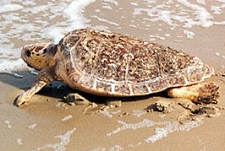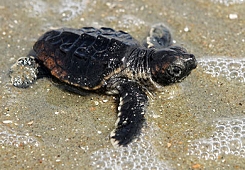Wildlife - Species

Status in SC: Federally Endangered
Loggerhead Sea Turtle
Globally, loggerhead sea turtle populations are considered to be in decline (NMFS & USFWS 2007), and are listed as endangered on the Red List of the International Union for the Conservation of Nature and Natural Resources and as Threatened or Endangered under the United States of America Endangered Species Act, depending on the distinct population segment (DPS, Federal Register 22 September 2011).

Loggerhead Sea Turtle (Caretta caretta)
Description
Loggerheads are one of seven species of marine turtles. Adult loggerheads have a reddish-brown shell, or carapace, with medium-yellow underside (plastron). The arrangement and number of scutes (the large scales or plates on the turtle’s shell and head) are used to identify each species of turtle. This species is third in size among marine turtles, with the leatherback and green turtles being the largest and second largest, respectively. Adult loggerheads average 113 kg (250 lbs) in weight. Hatchlings average 45 mm (1.7 in) in shell length, weigh about 20 g (0.6 oz), and are dull brown in color.
Preferred Habitat and Biology
Loggerhead sea turtles are found throughout the world’s oceans. In the western Atlantic, they are distributed from Newfoundland to Argentina. Pelagic immature individuals (dinner-plate size) are found in the eastern Atlantic near the Azores and Madeira. During summer months, loggerheads concentrate in lower latitudes to lay eggs. In the western Atlantic, four subpopulations of loggerhead turtles have been established based on nesting areas: the Northern Nesting Subpopulation, from North Carolina to northeast Florida; the South Florida Nesting Subpopulation from 29oN on the east coast to Sarasota on the west coast; the Florida Panhandle Nesting Subpopulation found at Eglin Air Force Base and the beaches near Panama City; and the Yucatan Nesting Subpopulation on the eastern coast of Yucatan, Mexico. Primary nesting sites in South Carolina are beaches between North Inlet and Price Inlet, with moderate nesting activity also occurring on beaches between Kiawah Island and Hilton Head Island. In the ACE Basin, loggerhead nesting activity occurs on beaches bordering St. Helena Sound, including Edisto Beach, Otter Island and Hunting Island. Loggerheads mate in coastal waters during the spring. Females then come ashore at night from May to August, to the same stretch of coastline where they hatched, to lay their eggs on sandy dunes. Upon reaching a suitable nest site, the female digs a flask-shaped cavity with her hind flippers and deposits an average of 115 round, leathery eggs. She then fills the cavity with sand, crawls over it, and obscures any tracks by using her front flippers to throw sand on the spot. The eggs incubate for approximately 2 months, and hatchlings usually emerge at night between 10 pm and 2 am. Then, as a group, they begin their crawl towards the ocean, where they mature in approximately 20-25 years.
Species Significance
The loggerhead sea turtle has been on the United States and South Carolina List of Endangered and Threatened Species since July 28, 1978. It is listed as a threatened species throughout its range and is still under intense pressure from local exploitation in many parts of the world. According to the South Carolina Department of Natural Resources, the numbers of nesting females in South Carolina beaches has declined at an alarming rate since 1980. This decline is attributed primarily to incidental catch in shrimp trawl nets. Federal law now requires the use of Turtle Excluder Devices, or TEDs, in shrimp trawls. Before the implementation of these devices, it is estimated that between 5,000 and 50,000 turtles died annually as a result of drowning in shrimp trawl nets. Other threats to the species include beach armoring (construction of groins, jetties, and similar structures to protect beachfront property from erosion) and nourishment, bright beachfront lighting, recreational beach equipment, non-native beach vegetation, nest depredation by raccoons and other predators, poaching, dredging, pollution, and commercial fishing gear. In South Carolina, raccoons are kept at bay from certain areas through volunteer trapping programs. In the ACE Basin, nesting beaches on Edisto and Hunting Islands are accessible enough to allow for trapping of raccoons. However, loggerhead nesting beaches on Otter Island are too remote to implement such programs. Of the four existing subpopulations in the western Atlantic, the South Florida Nesting Subpopulation is the largest one, averaging 64,000 nests per year in 1989-1995. It is the second largest loggerhead nesting assemblage in the world. Loggerheads that nest on beaches along the South Carolina coast belong to the Northern Nesting Subpopulation, which averaged 6,200 nests per year in 1989-1995.
References
Loggerhead/Green Turtle Recovery Team. 1991. Recovery Plan for U.S. Population of Loggerhead Turtle (Caretta caretta). National Marine Fisheries Service, National Oceanic and Atmospheric Administration, U.S. Department of Commerce, Silver Spring, MD.
Murphy, S. H. and G. Barnette (eds). South Carolina’s Endangered Species Portfolio - Loggerhead Sea Turtle. South Carolina Department of Natural Resources, Wildlife Diversity Section, Columbia, SC.
National Marine Fisheries Service and U.S. Fish and Wildlife Service. 1995. Status Reviews for Sea Turtles Listed Under the Endangered Species Act of 1973. National Marine Fisheries Service, National Oceanic and Atmospheric Administration, U.S. Department of Commerce, Silver Spring, MD.
National Research Council. 1990. Decline of the sea turtle: Cause and prevention. National Academy Press. Washington, DC. 259 pp.
Turtle Expert Working Group. 1998. Assessment of the Kemp's Ridley (Lepidochelys kempii) and loggerhead sea turtle population (Caretta caretta) in the Western North Atlantic. NOAA Technical Memorandum NMFS-SEFC-409. National Marine Fisheries.
